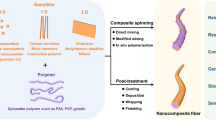Abstract
Epoxy nanocomposites based on a polymeric matrix DER330 + IMTHPA and 5 different nanofillers, i.e., silica of various sizes, aluminum nitride, aluminum oxide nanoparticles and nanofibers, were prepared. The weight content of nanoadditives in the matrix ranges from 0 to 4%. Dependences of mechanical properties of epoxy composites on the nature and concentration of the filler are investigated in a three-point bending test. The morphology of the fracture surface is studied. The complex analysis of the influence of nanoadditives makes it possible to reveal the optimal fillers and concentrations, allowing us to achieve a significant increase in elastic and strength characteristics of epoxy composites. It has been demonstrated that the introduction of A-380 silica nanoparticles into the matrix increases fracture stress by 30%. Composites with aluminum nitride nanoparticles show the highest mechanical values on the strength of all investigated parameters: growth in the elastic modulus is 12% upon an increase in fracture stress by 7%. The addition of aluminum oxide nanoparticles and nanofibers in the range of investigated concentration does not lead to significant changes in the mechanical characteristics of the composite.
Similar content being viewed by others
References
S. P. Bardakhanov, A. I. Korchagin, N. K. Kuksanov, A.V. Lavrukhin, R. A. Salimov, S. P. Fadeev, and V. V. Cherepkov, “The way to produce nanopowders by evaporating the initial matters at electron accelerator under atmospheric pressure,” Dokl. Akad. Nauk 409(3), 320–323 (2006).
S. A. Khvostov, A. V. Rogalev, E. S. Anan’eva, and V. B. Markin, “Tekhnologiya Polucheniya Nanostruktuirovannykh Kompozitsionnykh Materialov,” Polzunovsk. Vestn., No. 3, 162–166 (2007).
R. A. Krokhin, V. I. Solodilov, and Yu. A. Gorbatkina, “Properties of glass-plastics based on epoxy resin, filled by aerosol,” Mekh. Kompozits. Mater. Konstrukts. 15(3), 437–447 (2009).
I. I. Blagodatskikh, M. A. Chashkin, and V. I. Kodolov, “The way to form metal-carbon-polymer nanocomposites in nanoreactors of complicated polymeric matrixes and their application for modifying epoxy resins,” in Proc. Int. Sci.-Pract. Conf. Nanotechnologies for the Industry (Fryazino, 2010), pp. 203–208.
J. C. Smith, “Experimental values for the elastic constants of a particulate filled glassy polymer,” Rec. J. Natl. Bur. Stand. Phys. Chem. A 80(1) (1976).
A. F. Yee and R. A. Pearson, “Toughening mechanisms in elastomer-modified epoxies,” J. Mater. Sci. 21, 2475–2488 (1986).
Z. Hashin, “The elastic module of heterogeneous materials,” J. Appl. Mech. 29, 143–150 (1962).
B. Paul, “Prediction of elastic constants of multiphase materials,” Trans. AIME 218, 36–41 (1960).
O. Ishai and L. J. Cohen, “Strain-rate dependence of the elastic modulus of filled and porous epoxy composites,” Int. J. Mech. Sci. 9, 605–608 (1967).
T. Adachi, M. Osaki, W. Araki, and S.-C. Kwon, “Fracture toughness of nano- and micro-spherical silica-particle-filled epoxy composites,” Acta Mater. 56, 2101–2109 (2008).
T. H. Hsieh, A. J. Kinloch, K. Masania, J. Sohn Lee, and A. C. Taylor, “The toughness of epoxy polymers and fibre composites modified with rubber microparticles and silica nanoparticles,” J. Mater. Sci. 45, 1193–1210 (2010).
H. Li, Z. Zhang, X. Ma, M. Hu, X. Wang, and P. Fan, “Synthesis and characterization of epoxy resin modified with nano-SiO2 and γ-glycidoxypropyltrimethoxy silane,” Surf. Coat. Tech., No. 201, 5269–5272 (2007).
V. V. Zuev, S. V. Kostromin, and A. V. Shlykov, “Fulleroid fillers effect onto mechanical properties of polymeric nanocomposites,” Mekh. Kompozits. Mater. 46(2), 219–228 (2010).
A. Omrani and A. A. Rostami, “Understanding the effect of nano-Al2O3 addition upon the properties of epoxy-based hybrid composites,” Mater. Sci. Eng. A 517, 185–190 (2009).
C.-H. Chen, J.-Y. Jian, and F.-S. Yen, “Preparation and characterization of epoxy/γ-aluminum oxide nanocomposites,” Composites Part A 40, 463–468 (2009).
H. A. Al-Turaif, Effect of nano TiO2 partical size on mechanical properties of cured epoxy resin,” Prog. Org. Coat. 69(3), 241–246 (2010).
R. V. Akatenkov, V. N. Aleksashin, I. V. Anoshin, et al., “The effect of small additions of functionalized multilayer carbon nanotubes onto strengthening kinetics and properties of epoxy composites,” in Proc. Int. Forum on Nanotechnologies “Rusnanotech 08” (Moscow, 2008), pp. 410–412.
N. A. Chainikov, P. S. Belyaev, A. B. Mozzhukhin, et al., Resource Saving Technologies for Producing Metal-Polymeric Materials. Student’s Book (Tambov State Techn. Univ., Tambov, 2003), pp. 1–54 [in Russian].
A. L. Trenisova, “The way to produce composite materials on the base of epoxy oligomer and fillers,” Extended Abstract of Candidate’s Dissertation in Chemistry (D. Mendeleev Univ. of Chemical Technology of Russia, Moscow, 2009), pp. 1–18 [in Russian].
A. Yu. Ognev, A. M. Teplykh, V. A. Bataev, et al., “Composite material with polymeric matrix containing carbon nanotubes as a strengthening phase,” in Proc. All-Russian Sci.-Tech. Conf. “Science, Industry, Defense” (Novosibirsk, 2010), pp. 362–363.
T. A. Vaganova, S. Z. Kusov, M. M. Mitasov, and E. V. Malykhin, “Synthesis of polyfluoroaromatic oligoimides with terminal anhydride groups-modifiershardeners of epoxy resins,” Fluorine Notes. 6(91) (2013). http://notes.fluorine1.ru/public/2013/6-2013/letters/index.html
T. Brusentseva, A. Zav’yalov, L. Vikulina, S. Bardakhanov, T. Chimytov, and V. Syzrantsev, “Interaction between silicon dioxide and polymers,” Nanoindustr., Nauchno-Tekhnich. Zh., No. 1(39), 32–36 (2013).
Author information
Authors and Affiliations
Corresponding author
Additional information
Original Russian Text © T.A. Brusentseva, A.A. Filippov, V.M. Fomin, E.V. Malykhin, T.A. Vaganova, 2014, published in Rossiiskie Nanotekhnologii, 2014, Vol. 9, Nos. 11–12.
Rights and permissions
About this article
Cite this article
Brusentseva, T.A., Filippov, A.A., Fomin, V.M. et al. Influence of the nanosized filler nature on the mechanical properties of epoxy-anhydride polymer composites. Nanotechnol Russia 9, 638–644 (2014). https://doi.org/10.1134/S1995078014060068
Received:
Accepted:
Published:
Issue Date:
DOI: https://doi.org/10.1134/S1995078014060068




